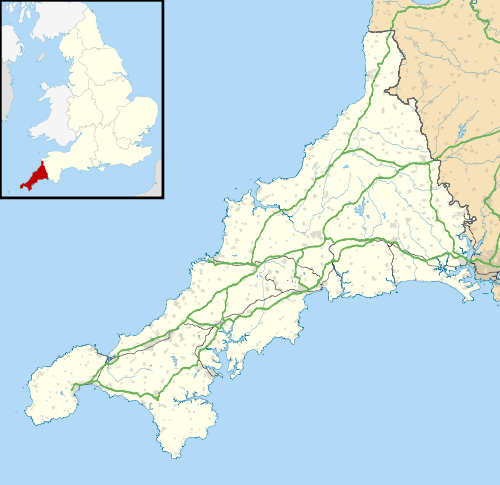Menheniot
| Menheniot | |
| Cornish: Mahynyet | |
 Menheniot parish church |
|
 Menheniot |
|
| Population | 1,655 (Civil Parish, 2011) |
|---|---|
| OS grid reference | SX289628 |
| Civil parish | Menheniot |
| Unitary authority | Cornwall |
| Ceremonial county | Cornwall |
| Region | South West |
| Country | England |
| Sovereign state | United Kingdom |
| Post town | LISKEARD |
| Postcode district | PL14 |
| Dialling code | 01579 |
| Police | Devon and Cornwall |
| Fire | Cornwall |
| Ambulance | South Western |
| EU Parliament | South West England |
| UK Parliament | South East Cornwall |
Coordinates: 50°26′24″N 4°24′43″W / 50.440°N 4.412°W

Menheniot (pronounced Men-en-yut) (Cornish: Mahynyet)[1] is a civil parish and village in Cornwall, England, United Kingdom. The village is 2 1⁄2 miles (4.0 km) southeast of Liskeard.[2] The meaning of the name is "sanctuary of Neot" (from minihi and Neot).[3]
Menheniot had a population of 1,605 in the 2001 census.[4] This had increased slightly to 1,655 at the 2011 census,[5] whereas the ward population at the same census was 3,658.[6] The village has a primary school, a pub, a shop and a post office.
Geography
To the south of the civil parish is Clicker Tor Quarry, a Site of Special Scientific Interest noted for its geological interest, containing one of the best examples of ultramafic rocks in South West England.[7]
At Coldrennick is a black and white mansion dated 1870 by the architect C. F. Hayward.[8] At Merrymeet is an Anglican mission church dedicated to St Mary the Virgin.
Parish church
The parish church, located in the village, is dedicated to St Lalluwy. It has a buttressed tower and a spire.[9][10] The alleged dedications to St Antoninus and St Corentin derive from errors made by John Whitaker and Dr George Oliver. The church is a fine building of the 14th century but has been rendered less interesting by unsympathetic restorations. Accounts of four guilds associated with the church have been preserved: they relate to part of the reigns of Queen Mary I and Queen Elizabeth I. The date of the parish feast was altered in 1405 from March 8 to October 6. In 1478 the benefice was appropriated to Exeter College, Oxford and the cure of souls became a vicarage. Five chapels in the parish are recorded in the Middle Ages but they were abolished at the Reformation. There was also a lazar house at Maudlin near Liskeard which did remain in existence for some time after. As a valuable benefice several of the incumbents have been men of some distinction, including William Wykeham in 1365, Peter Courtenay, afterwards Bishop of Exeter, in 1477, and John Moreman, DD, 1529-54.[11] Dr Moreman was the author of a commentary on the epistle to the Romans and also the first to teach his people the Lord's prayer, creed and ten commandments in English.[12] George Hall became vicar of Menheniot and in 1641 archdeacon of Cornwall.[13][14] He was deprived of his offices under the Commonwealth but became a bishop after the Restoration.
Features of interest include the ceiled wagon roofs, the pulpit (1891 by Harry Hems of Exeter), which depicts the polar exploits of Vice-Admiral Trelawney-Jago, and the earliest monumental brass in Cornwall (commemorating Sir Ralph Carmynow, d. 1386). There are a number of interesting monuments to the Trelawnys, including Jonathan Trelawny (d. 1674) and Edward Trelawney, Dean of Exeter (d. 1726). The black marble slab to L. Stephens (d. 1724) and the tablet to Lady Charlotte Carr (by M. Eames of Exeter) are also of interest.[15]
Captain John Richards Lapenotière who lived in the parish until his death in 1834 is buried in the churchyard.
Economy and transport
Menheniot lies in a former mining area and is surrounded by disused shafts and engine houses. Lead seams were discovered in the 1840s and Menheniot became the centre of a mining boom which lasted until the 1870s. During this period the population doubled.[9] Wheal Trelawney was a lead and arsenic mine which was worked from 1840 to 1890 and again in 1900-02. [16]
The village has a station, Menheniot railway station, on the Cornish Main Line which is operated by First Great Western.[17][18]
References
- ↑ Place-names in the Standard Written Form (SWF) : List of place-names agreed by the MAGA Signage Panel. Cornish Language Partnership.
- ↑ Ordnance Survey: Landranger map sheet 201 Plymouth & Launceston ISBN 978-0-319-23146-3
- ↑ Cornish Church Guide (1925) Truro: Blackford; p. 157
- ↑ Office for National Statistics: Census 2001 : Parish Headcounts: Caradon Retrieved January 2010
- ↑ "Parish population at 2011 census". Retrieved 9 February 2015.
- ↑ "ward population 2011 census". Retrieved 9 February 2015.
- ↑ "Clicker Tor Quarry" (PDF). Natural England. 1986. Retrieved 26 October 2011.
- ↑ Pevsner, N. (1970) Cornwall; 2nd ed. Harmondsworth: Penguin; p. 54
- 1 2 GENUKI; Menheniot; retrieved April 2010
- ↑ CofE churches website; retrieved April 2010
- ↑ Cornish Church Guide (1925) Truro: Blackford; p. 157-58
- ↑ Brown, H. Miles (1964) The Church in Cornwall. Truro: Blackford; p. 40
- ↑ http://www.british-history.ac.uk/report.aspx?compid=63712
- ↑ Concise Dictionary of National Biography
- ↑ Pevsner, N. (1970) Cornwall; 2nd ed., revised by Enid Radcliffe. Penguin; p. 117
- ↑ Todd, A. C. & Laws, Peter (1972) The Industrial Archaeology of Cornwall. Newton Abbot: David & Charles; p. 235
- ↑ National Rail website; Menheniot; retrieved April 2010
- ↑ British Railway Stations website; retrieved April 2010
External links
![]() Media related to Menheniot at Wikimedia Commons
Media related to Menheniot at Wikimedia Commons